Interested in a time capsule? One you can drive right off the dealer’s lot?
The 2023 GMC Savana van fits the bill. It hasn’t been changed much since 1996 – making it the only almost-30-year-old brand-new vehicle on the market.
But why would you want to buy it?
Maybe because it is – literally – built like they used to make ’em.
The Savana is a full-size van – not a minivan. It differs chiefly from the latter in that it’s built on a much heavier-duty (rear-wheel-drive) foundation and is available with a V8 engine, something no minivan has ever offered. It can also pull up to 10,000 pounds, which is more than twice as much as any minivan can handle.
It is also a spartan van, relative to what you’d find in a minivan.
The base 2500 series (and standard wheelbase) Work Van that stickers for $38,100 to start only has a driver and front passenger seat. With everything aft of that being open space for whatever you’d like to put there. It is why this van is so perennially popular with electricians, plumbers and other business owners who need something that can carry the tools of the trade to where their trade is practiced. But it can also serve as a passenger van – up to 15 of them – or even as the basis for an RV.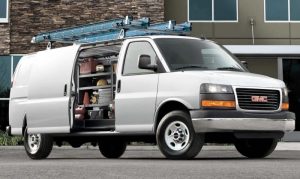
It’s a blank canvass, for you to paint as you like.
A top-of-the-line long-wheelbase, 3500 Series Passenger Van with a 6.6 liter V8 engine in place o the otherwise standard 4.3 liter V6, paired with a heavier-duty automatic transmission, stickers for $49,490.
What’s New for 2023
Though the Savana is – literally – a new antique (in most states, a vehicle qualifies for that status once it reaches 25 years old) the ’23 model comes with many features that were inconceivable 27 years ago, including standard Wi-Fi connectivity, Bluetooth and a number of modern electronic safety systems such as Forward Collision Alert, Lane Departure and Blind Spot Warning; both of these are standard in all trims.
What’s Good
Simple, tough, capable and configurable.
Massive cargo (and towing) capacity.
Costs about the same as a much smaller, far-less capable minivan.
What’s Not So Good
No factory high roof option (newer large vans such as the Dodge ProMaster and Mercedes Sprinter offer this).
No more diesel engine option.
Doesn’t ride like a minivan.
GMC offers the Savana with either a 4.3 liter V6 that make 276 horsepower or (optionally) a 6.6 liter V8 that makes 401 horsepower and a very stout 464 ft.-lbs. of torque.
Both are interesting engines.
The 4.3 V6 is a V8 – with two cylinders lopped off. It is based on the Chevy “small block” V8 and dates back . . . more than 27 years ago, to the era when GM needed an engine that was similar to a small-block V8, that wasn’t one. That would fit where a small block V8 would and that could be easily paired with the transmissions that were designed to bolt up directly to a Chevy small block V8.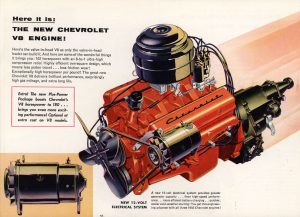
The answer was to keep the same configuration – including overhead valves (just two) rather than overhead cams and so maintain the compact dimensions (especially width) of the small block and retain the small block V8’s bellhousing, so that any transmission that worked with a small block V8 would also work with the “small block” V6.
Many internal parts are shared, too.
This engine is known to be durable and low maintenance. It has a timing chain – so you will never ave to spend any money on a timing belt change. There is no turbocharger to fail. It is as simple an engine as you can still buy new. And – unlike almost all new engines – it can be replaced inexpensively, if it ever becomes necessary to do so.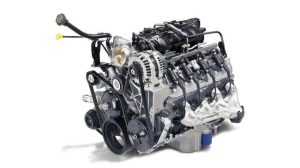
This one is paired with an eight speed automatic.
The Savana’s optional engine is a 6.6 liter V8, also descended from the “small block’ family of GM V8 engines. It is a much newer design, but it still features some of the old (dating back to 1955) V8’s original – and then innovative – design features, including overhead valves (just two) activated by pushrods via a single camshaft, mounted in the valley of the “v.” This is a compact configuration that leaves more room in the engine bay as well as fewer parts within the engine that might fail one day.
Equipped with this engine – which also comes paired with a heavier-duty six speed automatic in place of the eight speed automatic that comes with the V6 – a Savana can pull a 10,000 pound trailer and carry as much as 3,280 pounds of payload inside the cargo area.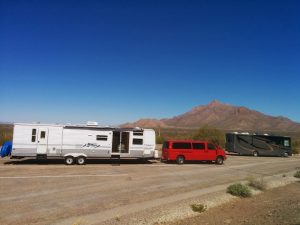
Most minivans have a maximum tow rating of 3,500 lbs.
Sadly, the third engine that was available in the Savana until this year – a 2.8 liter turbo-diesel – no longer is. This engine produced much more torque (369 ft.-lbs.) than the gas 4.3 liter V6 (just 298 ft.-lbs.) while using considerably less fuel than the 6.6 liter gas V8. It thus offered the buyer who wanted more grunt than the V6 could deliver – without the gas bill you got with the V8 – something in the middle.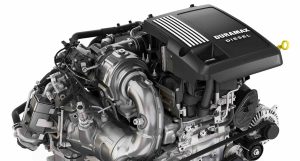
But it has become almost impossible to get any diesel engine through the gantlet of regulations required prior to being “certified” for sale by the government – without it becoming so expensive to sell that few people want to buy it anymore. This is why diesel engines are fading away even in the heavy-duty 2500-3500 series truck/commercial vehicle market. It is why Ford designed and now offers a massive a brand-new 7.3 liter V8 engine that is almost as big (and thirsty) as the biggest gas V8s of 27 years ago. Such an engine is still cheaper to make – and so easier to sell – than a modern, “certified” diesel engine – and you will never have to put DEF in the tank, either.
As far as gas mileage: EPA does not publish figures for vehicles in the 2500/3500 class but expect to average between 13 and 15 miles-per-gallon. A 31 gallon tank gives this more range than any EV – some 400 miles on the low end – and you don’t have to worry about finding a “fast” charger – or waiting there for half an hour or more before you can get going again. 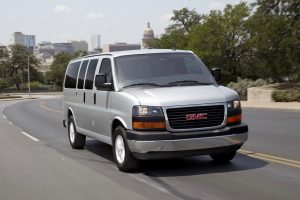
On The Road
The Savana is one of the few vehicles designed in the Before Time, when rear-wheel-drive (and V8 power) were common and for that reason, most people had experience with that layout. In our time, V8s – even in trucks – are becoming uncommon and rear-wheel-drive is almost exclusively found in luxury cars. So it’s funny – and sad – to drive a vehicle that has both that’s neither.
It feels solid and heavy and powerful, which it should – because it is. V8-equipped Savanas can be made to perform an impressive burnout, especially if ordered with the available Eaton locking axle, which lets you smoke them both.
Empty, the thing is pretty fast, too.
Zero to 60 in about 7.3 seconds, which would have almost kept pace, 27 years ago, with a Mustang GT. It sounds faster – because the engine is right there by your right leg, under that big hump that partially separates the driver’s area from the front seat passenger’s area.
Well, some of it is.
That’s how they kept the nose stubby, in these old vans. The engine would be recessed into the firewall, with about half of the engine under a hump that protruded into the passenger cabin.
In the Before Time, sometimes people would remove the cover so the engine was literally right there and – if the engine had a big four barrel carb – you could watch (and hear) the secondaries open up when you floored it.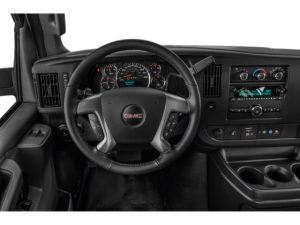
Good times!
In these times, what you’ve got is what you had 27 years ago. A simple machine that’s as straightforward to drive as vehicles were, in the Before Time. There is a column shifter – not a toggle or wheel. There is no LCD display – not even in the center stack. There are knobs to control the AC. It even still has a key – and an ignition switch – rather than an electronic fob and a “start” button.
There’s a happy familiarity about all of this, if you began driving in the Before Time. It is almost like going to a car museum and being allowed to take some of the antiques out for a spin.
Just be aware that’s exactly what it will do in the snow – and the wet, if you don’t spring for the optional Eaton locking differential. If you grew up driving modern front-drive/all-wheel-drive vehicles, you may not have inexperienced the way rear-drive vehicles slip when traction is low. Especially when they are light in the tail. Of course, this is also fun – and challenging, which is part of the fun. If you can drive a rig like this in the snow, you can drive anything better than those who never acquired the skill. 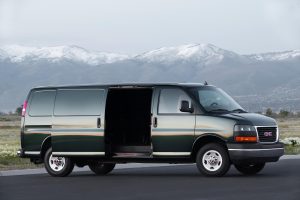
At The Curb
Even the standard wheelbase 2500 Savana is nearly as long as a full-size, half-ton pickup like the Chevy Silverado with an eight foot bed. The long wheelbase Savana is longer – by almost a foot. That’s how you carve out 283.6 cubic feet of cargo space inside the latter. Which – to give you some sense of just how much that is – it’s nearly three times as much cargo space as you’d get inside a “full-size” minivan like the Toyota Sienna (101.1 cubic feet).
It is so much space you could – literally – live inside a Savana.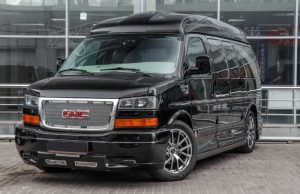
Not uncomfortably, either. There is enough space to create a home-on-wheels, with kitchenette, lounge area, sleeping area and even a bathroom. This is a fairly common thing that people do with these big vans and the Savana’s only failing here is you cannot quite stand up inside it without crouching down a little, on account of the roof height. Some of the others in this class, such as the Ram ProMaster and Mercedes Sprinter, do offer high-roof versions and that makes them more amenable to being converted into homes-on-the-go. But neither of the latter even offer a V8 (though the Sprinter is available with a turbodiesel). The Nissan NV van used to come standard with a V8 and was available with a high roof.
But Nissan stopped selling this model back in 2021.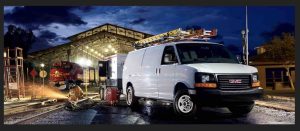
If you prefer not to live in a van down by the river, the space inside is also massive enough to accommodate seats for a dozen or half that number, in a more luxurious setting. Or, maybe no seats at all – to make room for your tools or toys. This van can carry a couple of motorcycles inside – and out of the weather – plus another several on a trailer hitched to the back.
If you opt for the passenger van, the maximum tow rating dips slightly to 9.600 lbs. But you also get passenger-friendly swing-out side doors and door glass; the Work Van does not. However, the latter does come standard with power windows (for the driver and front seat passenger) as well as AC, a two-speaker stereo, Fleet Management connected services and a leather-wrapped steering wheel.
You can get deployable Access Steps for the passenger van.
The Bottom Line
Cher sang about turning back time. Here’s a way to drive it.
. . .
If you like what you’ve found here please consider supporting EPautos.
We depend on you to keep the wheels turning!
Our donate button is here.
If you prefer not to use PayPal, our mailing address is:
EPautos
721 Hummingbird Lane SE
Copper Hill, VA 24079
PS: Get an EPautos magnet or sticker or coaster in return for a $20 or more one-time donation or a $10 or more monthly recurring donation. (Please be sure to tell us you want a magnet or sticker or coaster – and also, provide an address, so we know where to mail the thing!)
My eBook about car buying (new and used) is also available for your favorite price – free! Click here. If that fails, email me at EPeters952@yahoo.com and I will send you a copy directly!





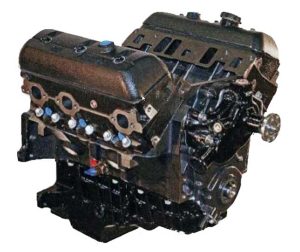









Who doesn’t like a mobile love palace?
Down here in TX, pickups are where it’s at. I’m from Virginia. I’ve always been more of a van guy. You have 8’+ of usable bed, smaller wheelbase, easier to drive and park, and your stuff stays more secure.
I can’t tell you how many friends I’ve had that have lost their tools with a pickup toolbox, which blows out 2′ of cargo room.
It also makes me wish they still had the Astro/Safari. It had a similar ruggedness as the Savanah (I think it had something like two frames combined; a variety of body-on-frame) but still could get 15 mpg or higher when towing a heavy load
Amen to that, dood. I was a long distance independent courier from ’99-’04, doing 80K to 95K annually. I drove two (used) AWD Astro’s into an early death, but I loved ’em. Each went way over 250,000 miles. One trans replaced. But those 4.3 V6’s were bullet proof.
My first car in ’63, as a high school junior, was a ’50 2 dr. Chevy Fleetline. It had a key, and a chrome “start button” on the dash. Those start buttons disappeared by the time I got a ’55 Chevy, and then returned many decades later. As what, new cutting-edge technology? Go figure.
I’ve been saying for a while, that this is one of the few new vehicles I would buy if I could afford one (I’d love the extended-length 15-passenger version)
Wait…wait…. GM of all companies has somehow managed to have enough sense to keep producing a REAL full-sized traditional van, while Ferd and Chrudler have killed off theirs in favor of those generic other things which are generally not suitable for individuals/families, and can in no way take the place of the Econoline or Tradesman et al.
Killing off the Econoline was the stupidest thing Ford has done thus far. Kudos to GM for making an uncharacteristically wise decision…for once!
Wow, a practical dashboard with actual knob controlled HVAC? No “TV” screen cluttering up the dash? And comfy looking cloth seats? If I wasn’t in snow country I’d dump the POS 2018 Jeep and grab one of these. Couldn’t drive any worse than the Jeep in the wind.
If the pearl clutching panties in a twist car folks at the consumer mags were really concerned about safety they’d embrace this dash design – modern touch screens equal eyes off the road. Analog controls just a quick glance and in a bit your familiarity will allow adjustments just by feel. Same with real gauges, your brain instantly knows good/bad via an analog needle. A number read out means interpretation, no thanks.
You nailed it, Sparkey. I used to drive Econoline vans before extra-cab/crew cab pick-ups and Excursions were a thing. Loved ’em, but man, they DO get buffeted in the wind- and the rear wheels slip if they so much as see a cloud in the sky! (Excursions are great in the wind though…ya don’t even notice, because they weigh so much- and ya rarely even need the 4×4).
Eric, remember when I was a child we always had a ford econoline van in the 80s up to the mid 90s when I left the US – what ever happened to them? We used to travel all over the place in them. The later ones we had were better equipped than any luxury car today – captain seats, rear seat that becomes a bed at the push of a button, a TV, VCR, even Nintendo! Along with surround sound, whats now called “mood lighting” even (ok not all the colours) but you get the idea. It was basically an E150 customised by a company called “explorer”. What happened to those ?! The obsession ppl have with gadgets in cars I thought those would be very popular now!!
Morning, Nasir!
Ford cancelled the Econoline int he U.S. back in ’09, if you can believe it. Like you, I used to see these everywhere…
I think they lasted up until 2014, though they had been renamed to just E-Series by then. My family also had an Econoline conversion (a 1984 with the 351) that I loved driving when I turned 16. I still remember the floor-operated high-beam switch in the left foot well area, which I wish still applied to newer vehicles
The private high school that I work at has a fleet of nine of the Chevy Express version. Eight of them are mini-bus conversions. Two are brand new 2022’s, with the backup camera screen on the rear view mirror (which actually is where that should be if your gonna have that). One is a 2014, another two are 2012’s. The rest are an assortment of model years dating back to about 1999 (older than the students ha ha). Even though some are pretty old, most still have only about 60,000 to about 80,000 miles on them.
The only one that isn’t a conversion is the oldest, the last of the passenger vans (they had to start operating minibuses rather than 15 passenger vans). It’s no longer used to move students (the seats have been removed and thrown out), it’s used to move stuff when needed. It’s body is falling apart and rusting and probably won’t be around much longer. It’s actually quite bizarre to have it parked next to the brand new ones, since they are almost the same, except that two are fresh from the factory and the other is about ready for the scrap yard.
The engines are rock solid and rarely break. Sensors are the biggest problems (on the newer ones ironically enough since they have more of them). The V8’s have plenty of power to move those minibuses with no problem.
Unfortunately they need frequent inspections from both Indiana and Illinois state police (we are on the border, some of them are registered in Indiana, some in Illinois). The Illinois ones have municipal plates so no pollution tests at least. I don’t know how we managed to get municipal plates.
The nice thing about them is you don’t need a CDL to drive them even with passengers. So any staff member, teacher or trusted students can drive them. Most of the students come from homes that have Tahoes sized SUV’s, minivans or pickups so they are no problem for the students to drive, since most drive big vehicles at home already.
Eric,
A minor correction: per GM’s website the cargo version of the Savanah is indeed available with swing doors; in fact, it comes standard with them, though the sliding door is an option.
My son is an electrician. Guys on the job site love them. Keeps gear out of the rain & away from prying eyes. Configurable with shelves. I’ve seen several RV vans at the campgrounds. Usually driven by women camping alone. Makes an easy to handle camper for one person to negotiate and set up.
‘The Ram ProMaster and Mercedes Sprinter do offer high-roof versions.’ — eric
ProMaster and Sprinter seem to be the favored rigs for conversion vans now, thanks to those high roofs.
Hate to think of driving them in strong winds, though. My old G10 Chevy van was like piloting a sailboat in crosswinds, taking on a noticeable tilt and tracking in a series of scallops rather than a straight line, as wind gusts buffeted it. The high-roof ProMaster looks top heavy because it’s so tall.
An aftermarket pop top is one solution. Some of them even offer a drop-down double bed, suspended from the pop top. This could make the new Savana a great old-tech base for a conversion van. Simple is good.
mpg is mostly about weight. I am currently getting 8-9 towing 5K with my v8 ram.
These vans can carry approx. 4K payload, and then their mpg will go down to 8-10 as well.
That’s why the diesel option is always better when towing/hauling because they lose much less mpg when towing/hauling, but our fed is eliminating them.
When we were still a proper country a decked out Conversion van was the American dream, more achievable than the Winnebago. In this day and age would it have airbrushed Manga on the sides now?
The swing out side door is far, far better than the sliding door. Simple. Those sliding doors get hard to open, end up not fitting/closing right and are a PITA. I had a ’98 Ford E150. Put about 200k on it. Taught four daughters how to drive in it. Sold if for 600bux with a blown head gasket. Wished I still had it. (minus the blown head gasket, of course) As an empty nester, I would have turned it into a camper van
Reference to Cher and a pic of The Clintons? Yikes! Are you subliminally discouraging us from buying this vehicle? 😀
The Clinton era was the last where they didn’t significantly fuck with the designs of cars. Bush was the one who began promulgating changes to FMVSS rules that plague the designs of modern cars and trucks. That began in his second term. The rules were written in 2005 or 6 and were phased in between 2007 and 2011.
Bush also signed the Democrat’s Energy Conservation Act or (was it Energy Policy Act) which began requiring cars get 35 mpg by 2020. Obama opted for an earlier phase in by 2016 of the 35 mpg requirement.